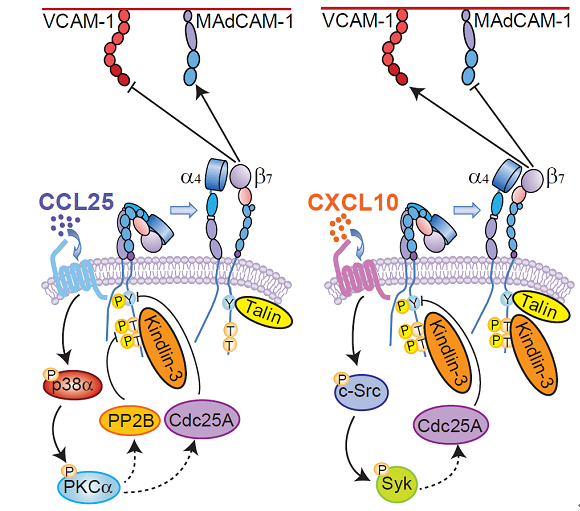
Researchers Reveal Switch of Integrin Ligand Specificity by Different Chemokines
Jun 25, 2014 Email"> PrintText Size

The immune surveillance and host defense depend on the precisely regulated trafficking of lymphocytes. The interaction between integrin and its ligand enables the targeting of lymphocytes to different tissues. Integrin a4b7 mediates lymphocyte homing to gut-associated lymphoid tissues through its interaction with MAdCAM-1, which is specifically expressed in the gut; whereas it also binds VCAM-1 which is widely expressedin other tissues. In order to maintain the specificity of lymphocyte homing to tissues that express either MAdCAM-1 or VCAM-1, a4b7 needs to distinguish one ligand from the other. However, the mechanism by which a4b7 selects between different binding ligands is unknown.
Dr. SUN Hao and Dr. LIU Jie led by Professor CHEN Jianfeng from the Institute of Biochemistry and Cell Biology, Shanghai Institutes for Biological Sciences of the Chinese Academy of Sciences, firstly demonstrate the switch of integrin a4b7 ligand-specificity by different chemokines to mediate selective adhesion of lymphocytes to either MAdCAM-1 or VCAM-1, and also importantly, the molecular mechanisms involved. CCL25 stimulation promotes a4b7-mediated lymphocyte adhesion to MAdCAM-1 but suppresses cell adhesion to VCAM-1, whereas CXCL10 stimulation has the opposite effect. Using separate pathways, CCL25 and CXCL10 lead to different phosphorylation of the b7 tail and distinct talin and kindlin-3 binding patterns, resulting in different integrin conformations and unique affinities for different ligands.
This study provides a novel concept for keeping the precision of tissue-specific lymphocyte homing. Moreover, other members of integrin family might use the same mechanism to distinguish different ligands.
This work entitled “Distinct Chemokine Signaling Regulates Integrin Ligand Specificity to Dictate Tissue-Specific Lymphocyte Homing” was published online in Developmental Cell on June 19, 2014. It is funded by grants from the Ministry of Science and Technology of China, the National Natural Science Foundation of China, Chinese Academy of Sciences, and the Science and Technology Commission of Shanghai Municipality.

Schematic of Integrin Ligand Specificity Switch by Distinct Chemokine Signaling. Stimulation by CCL25 and CXCL10 individually activates p38a MAPK/PKCa and c-Src/Syk signal pathways respectively, which results in distinct dephosphorylation of the b7 cytoplasmic domain by Cdc25A and PP2B. The different phosphorylation states of b7 cytoplasmic domain lead to distinct binding of talin and kindlin-3 to the b7 tail that induce different activated forms of a4b7 to mediate lymphocyte adhesion to either MAdCAM-1 or VCAM-1. (Image by Prof. CHEN Jianfeng`s group)
The immune surveillance and host defense depend on the precisely regulated trafficking of lymphocytes. The interaction between integrin and its ligand enables the targeting of lymphocytes to different tissues. Integrin a4b7 mediates lymphocyte homing to gut-associated lymphoid tissues through its interaction with MAdCAM-1, which is specifically expressed in the gut; whereas it also binds VCAM-1 which is widely expressedin other tissues. In order to maintain the specificity of lymphocyte homing to tissues that express either MAdCAM-1 or VCAM-1, a4b7 needs to distinguish one ligand from the other. However, the mechanism by which a4b7 selects between different binding ligands is unknown.
Dr. SUN Hao and Dr. LIU Jie led by Professor CHEN Jianfeng from the Institute of Biochemistry and Cell Biology, Shanghai Institutes for Biological Sciences of the Chinese Academy of Sciences, firstly demonstrate the switch of integrin a4b7 ligand-specificity by different chemokines to mediate selective adhesion of lymphocytes to either MAdCAM-1 or VCAM-1, and also importantly, the molecular mechanisms involved. CCL25 stimulation promotes a4b7-mediated lymphocyte adhesion to MAdCAM-1 but suppresses cell adhesion to VCAM-1, whereas CXCL10 stimulation has the opposite effect. Using separate pathways, CCL25 and CXCL10 lead to different phosphorylation of the b7 tail and distinct talin and kindlin-3 binding patterns, resulting in different integrin conformations and unique affinities for different ligands.
This study provides a novel concept for keeping the precision of tissue-specific lymphocyte homing. Moreover, other members of integrin family might use the same mechanism to distinguish different ligands.
This work entitled “Distinct Chemokine Signaling Regulates Integrin Ligand Specificity to Dictate Tissue-Specific Lymphocyte Homing” was published online in Developmental Cell on June 19, 2014. It is funded by grants from the Ministry of Science and Technology of China, the National Natural Science Foundation of China, Chinese Academy of Sciences, and the Science and Technology Commission of Shanghai Municipality.

Schematic of Integrin Ligand Specificity Switch by Distinct Chemokine Signaling. Stimulation by CCL25 and CXCL10 individually activates p38a MAPK/PKCa and c-Src/Syk signal pathways respectively, which results in distinct dephosphorylation of the b7 cytoplasmic domain by Cdc25A and PP2B. The different phosphorylation states of b7 cytoplasmic domain lead to distinct binding of talin and kindlin-3 to the b7 tail that induce different activated forms of a4b7 to mediate lymphocyte adhesion to either MAdCAM-1 or VCAM-1. (Image by Prof. CHEN Jianfeng`s group)
CAS Institutes
There are 124 Institutions directly under the CAS by the end of 2012, with 104 research institutes, five universities & supporting organizations, 12 management organizations that consist of the headquarters and branches, and three other units. Moreover, there are 25 legal entities affiliated and 22 CAS invested holding enterprisesThere are 124 I...>> more
Contact Us

Chinese Academy of Sciences
Add: 52 Sanlihe Rd., Xicheng District, Beijing, China
Postcode: 100864
Tel: 86-10-68597592 (day) 86-10-68597289 (night)
Fax: 86-10-68511095 (day) 86-10-68512458 (night)
E-mail: cas_en@cas.cn

